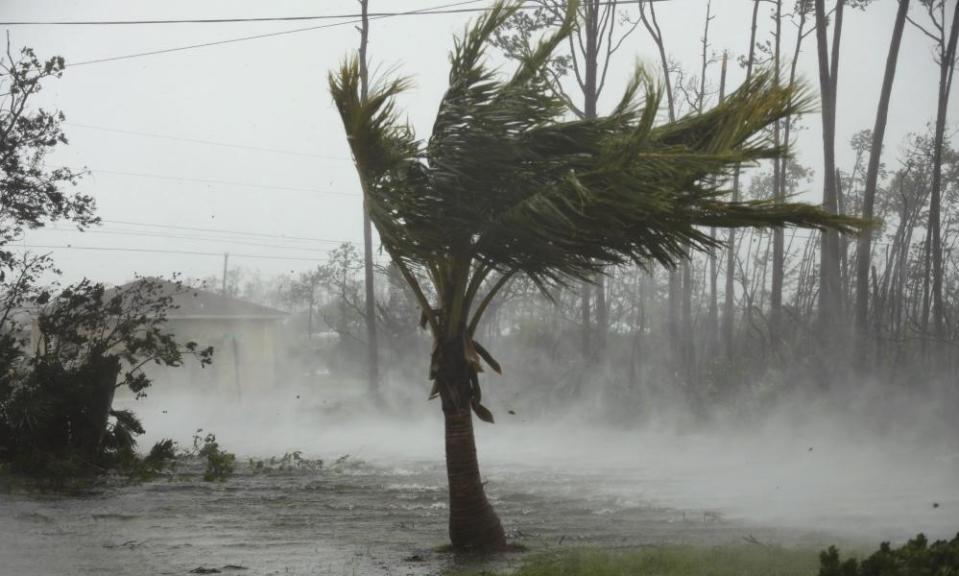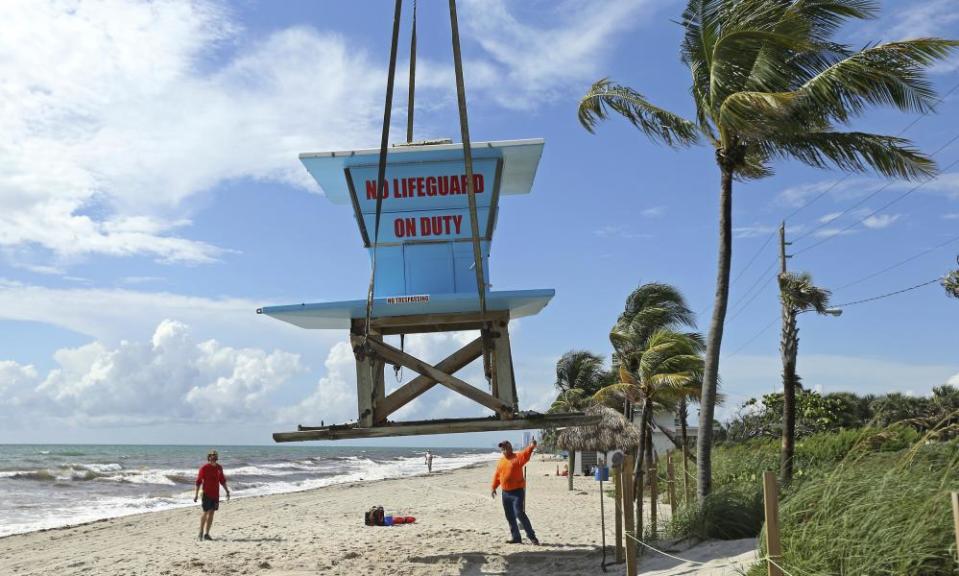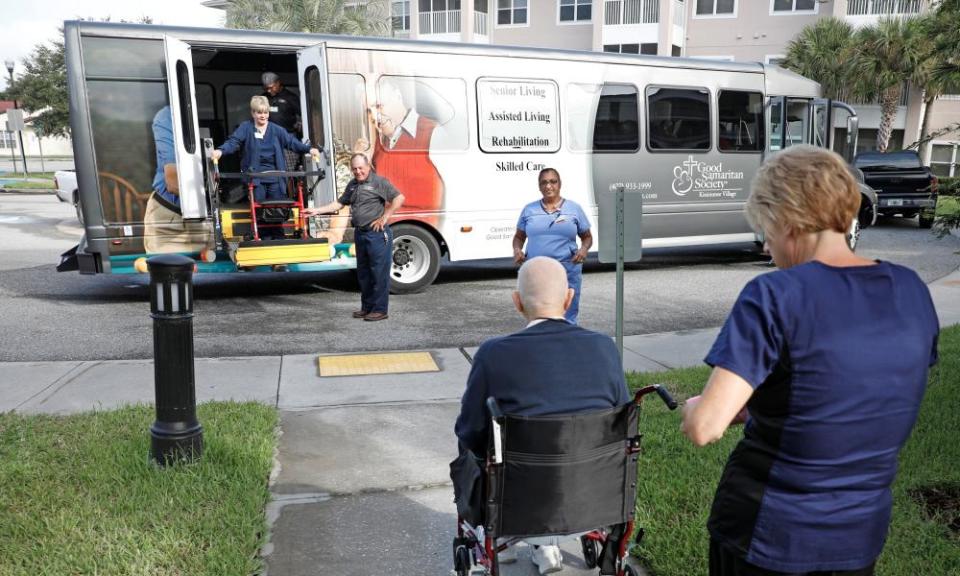Hurricane Dorian: millions in coastal US warned to 'get out now' ahead of storm

Hurricane Dorian, the most powerful Atlantic cyclone in decades, turned its deadly sights towards the US mainland on Monday night after two days slamming the northern islands of the Bahamas with wind gusts above 200mph that have claimed at least five lives.
Officials in Florida, Georgia and the Carolinas ordered millions of coastal residents to evacuate inland to safety ahead of the expected midweek arrival of the unpredictable monster storm.
Strong winds were already battering the coast on Monday afternoon north of Miami, and Floridians on the eastern edge of the state are braced for risky tropical storm conditions from the early hours of Tuesday onwards even if the hurricane does not make landfall on the US mainland but passes within a few dozen miles.

At a Monday morning press conference, Florida’s governor, Ron DeSantis, warned residents of his state to “remain vigilant” and urged those in coastal evacuation zones from Palm Beach to the Georgia border to relocate inland.
“Get out now while you have time, while there’s fuel available and you’ll be safe on the roads,” he said.
He added: “We’re going to have some impacts one way or the other. Hopefully by tonight we’ll have a sense of [Dorian’s] movement, and once we see the definitive movement north that’s going to allow us to even more concisely identify the places along Florida’s coast that are most at risk.”
Dorian has already left a trail of “unprecedented destruction” during its slow two-day crawl through Abaco Island and Grand Bahama, in the archipelago off Florida’s south-east coast.

With wind gusts above 200mph and a storm surge of more than 20ft, Dorian tore into the islands, destroying or severely damaging more than 13,000 homes, according to the Red Cross, and claiming at least one life, a seven-year-old boy who drowned in Abaco.
“Based on information out of Abaco, the devastation is unprecedented,” Hubert Minnis, the Bahamas prime minister, said in a tweet.
“Dorian remains an extremely dangerous storm. Our focus right now is rescue, recovery and prayer.”
Minnis said at least five people were known to have died, including a seven-year-old boy who drowned in Abaco.
Residents in the Bahamas shared videos on social media showing scenes of catastrophic winds, torrential rain and flooding. There were also unconfirmed reports of bodies seen in Abaco that officials said first responders would investigate when conditions allowed.
After parking itself over Grand Bahama for almost nine hours on Monday, Dorian was expected to pick up speed overnight and move north-west towards Florida’s east coast, then turn north on a path closer to Georgia and the Carolinas by midweek.

Despite weakening slightly to a category 4 storm on Monday, still with winds of 145mph, experts at the National Hurricane Center in Miami warned of “life-threatening storm surges and dangerous hurricane force winds”, even if the centre of Dorian follows its predicted path of remaining out at sea.
“Although the center of Dorian is forecast to move near, but parallel to, the Florida east coast, only a small deviation of the track toward the west would bring the core of the hurricane onshore,” Daniel Brown, a senior hurricane expert at the NHC, said in a Monday evening advisory.
“The hurricane is not a point and life-threatening storm surge and hurricane-force winds extend far from the center. Regardless of the exact forecast track, strong winds and a life-threatening storm surge are likely along the US east coast from Florida to the Carolinas.”
Experts have acknowledged that this storm’s precise course has been more difficult than most to plot, partly due to quickly changing patterns of steering atmospheric ridges in the Atlantic.
At 5pm on Monday, Dorian was still 105 miles east of West Palm Beach, home to Donald Trump’s Mar-a-Lago resort, and plodding slowly west at 1mph, with hurricane force winds extending 45 miles from its core.
In South Carolina, Governor Henry McMaster announced the evacuation of eight coastal counties, affecting more than 800,000 residents, adding to earlier orders issued for large numbers of counties along the coasts of central and north Florida and Georgia.

Evacuations in Florida included a number of hospitals and dozens of nursing homes and assisted living facilities along the coast. Orlando and Fort Lauderdale international airports were closed until further notice and rail services suspended.
Dorian marked the fourth consecutive year that at least one Atlantic cyclone had reached category 5 status, denoting sustained winds topping 157mph, according to the NHC. Hurricane Matthew in 2016 followed a similar offshore track to Dorian’s expected path yet still caused hundreds of billions of dollars of damage in the US and 47 deaths.
In 2017 Irma and Maria ripped through the Caribbean, the latter blamed for more than 3,000 deaths in Puerto Rico. Last year’s Hurricane Michael wrecked areas of the Florida Panhandle that are still struggling to recover.
There is growing evidence that the climate crisis, through the warming of the atmosphere and higher sea temperatures, is contributing to a pattern of fiercer, more destructive hurricanes.
Meanwhile, the UK’s Ministry of Defence announced that the Royal Fleet Auxiliary support vessel Mounts Bay, which has been in Caribbean since June, would shortly arrive in the Bahamas to help with recovery efforts.
The US Coastguard said it had rescue and recovery crews stationed on Andros Island ready to move in when conditions eased.

